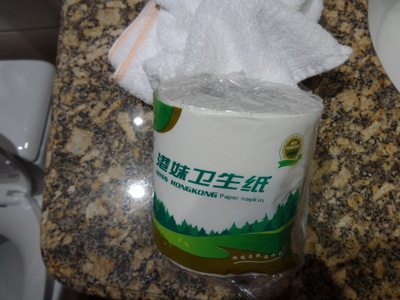 This photo of a toilet roll, labeled "paper napkins," pretty much says it all. The whole Chinese concept of paper-product and napkin use and nomenclature seems to be at about a 90° angle to ours.
This photo of a toilet roll, labeled "paper napkins," pretty much says it all. The whole Chinese concept of paper-product and napkin use and nomenclature seems to be at about a 90° angle to ours.Napkin etiquette
 This photo of a toilet roll, labeled "paper napkins," pretty much says it all. The whole Chinese concept of paper-product and napkin use and nomenclature seems to be at about a 90° angle to ours.
This photo of a toilet roll, labeled "paper napkins," pretty much says it all. The whole Chinese concept of paper-product and napkin use and nomenclature seems to be at about a 90° angle to ours.
In restaurants of sufficient pretention to use cloth napkins, the napkins are usually folded into some decorative shape and placed on the diner's plate, just as they would be in a French of American restaurant, but they are apparently not intended to be placed in the diner's lap. Instead, as soon as the diner is seated, a waiter picks up the napkin, shakes out the folds, and spreads it on top of the place setting, with a corner toward the middle of the table, the napkin's diagonal even with the table edge, and the remaining corner dangling toward the diner's lap. The waiter then proceeds to move each piece of the place setting out from under the napkin and to place it on top, to recreate the original place setting, but on top of the napkin, which remains there throughout the meal, serving as a sort of placemat on top of the tablecloth.
For finger-wiping purposes, a few tiny paper cocktail napkins are usually provided in a miniature napkin holder.
Local seafood
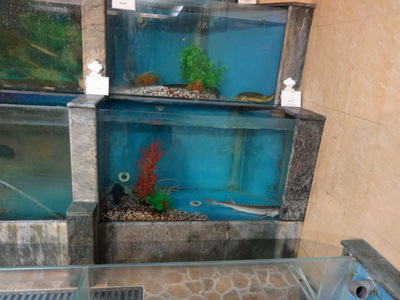
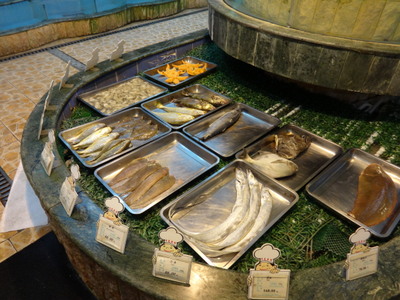 Here are some photos of the seafood array in our hotel's Qindao-cuisine restaurant. At the left, in the upper tank, are a single live eel (lying on the bottom) and a turtle, maybe 8 inches in diameter, with his head stuck into the corner of the tank. Below them are a fish I couldn't identify and a small sturgeon (also with its head stuck into the corner of the tank). I didn't see sturgeon on the menu, but I suspect that items are available that we were never offered. We were offered (but did not order) "stewed turtle rim."
Here are some photos of the seafood array in our hotel's Qindao-cuisine restaurant. At the left, in the upper tank, are a single live eel (lying on the bottom) and a turtle, maybe 8 inches in diameter, with his head stuck into the corner of the tank. Below them are a fish I couldn't identify and a small sturgeon (also with its head stuck into the corner of the tank). I didn't see sturgeon on the menu, but I suspect that items are available that we were never offered. We were offered (but did not order) "stewed turtle rim."
In the tank to the left of the turtle (though you can't see them here) were aquacultured, single-serve-size live abalone, and above those were two geoducks, clams the size of my forearm adorned with little six-inch shells entirely inadequate to enclose their bulk. Other tanks held other unidentified fishes, and one contained octopuses, but as they were all lying on their backs, I don't think they were alive.
In trays nearby were rows of dead fish. Behind the tray with the long, skinny silver-colored fish is a single pompano-like specimen and, as at the other restaurant, a single large disembodied fish head. I'm pretty sure I saw photos on a menu somewhere that implied you could order a large, whole, roasted fish head if you wished.
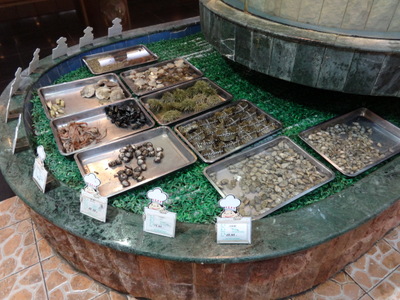
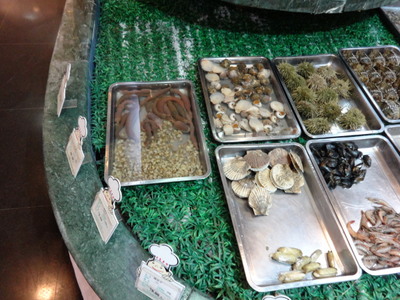 Here are some of the invertebrates on offer. In the photo at the left, the nearest trays hold small live bivalves, then crabs (each trussed up with black and white string) and a few of a different bivalve, then green sea urchins, mussels, and shrimp.
Here are some of the invertebrates on offer. In the photo at the left, the nearest trays hold small live bivalves, then crabs (each trussed up with black and white string) and a few of a different bivalve, then green sea urchins, mussels, and shrimp.
Beyond those, shown in a closer view in the right-hand photo, are a few small razor clams, some live scallops, and some sort of gastropods that were spreading their feet at the surface of the water and hanging upside down under them. Finally, in the left-hand tray are sipunculids (acorn worms) and what looks like a heap of little cooked, deshelled snails. No sea cucumbers on display, although they featured prominently on the menu and are a specialty of the region.
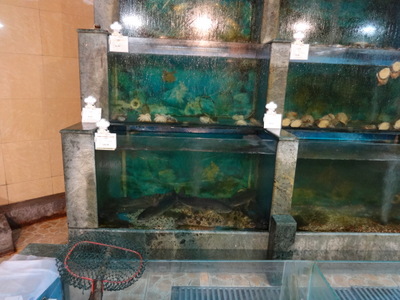
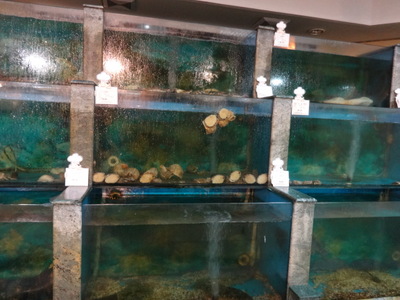 Here are two more views of the tanks. In the left-hand photo, at the bottom left are some dark grayfish-shaped fish, reminiescent of our gray mullet, and a couple of long, skinny rat-tailed fish on the bottom. To the right of that tank is one with a couple of single-serve size flatfish, flounder or some such.
Here are two more views of the tanks. In the left-hand photo, at the bottom left are some dark grayfish-shaped fish, reminiescent of our gray mullet, and a couple of long, skinny rat-tailed fish on the bottom. To the right of that tank is one with a couple of single-serve size flatfish, flounder or some such.
Above the gray fish is a tank containing a couple of bright white octopuses. The reason they appear white is that they're lying on their backs. I'm not sure whether or not they were alive. Above the flounder are fist-sized gastropods, many of them clinging to the glass front of the aquarium. Above those are a couple of small crabs.
In the right-hand photo you get a better view of the gastropods (center) and, above and to the right of them you can make out a geoduck, including the small halves of its bivalve shell, clinging to the top and bottom of its right-hand end.
I wish I'd gotten more photos of the seafood, because it was amazingly varied, and in many establishments, the tanks were cleaner and the water clearer.